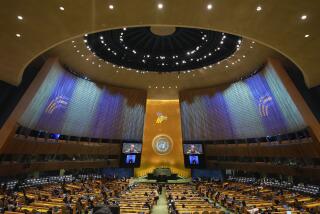U.S. Shifts Stand on a Space Defense Accord : Presents Draft Pact to Soviets, Drops Bid to Deploy ‘Star Wars’ at End of ABM Treaty Period
- Share via
WASHINGTON — The United States presented a draft agreement on space defenses to the Soviet Union in Geneva on Friday in which the Reagan Administration modifies a key previous stand but remains firmly committed to testing technologies that would become part of its anti-missile program, known as the Strategic Defense Initiative.
The Administration, at the urging of the Joint Chiefs of Staff, has dropped its insistence that space-based missile defenses could be automatically deployed at the end of a negotiated period during which both superpowers would agree to adhere to the 1972 Anti-Ballistic Missile Treaty, according to U.S. officials. The Soviets have urged that this period be 10 years; the United States has proposed seven years.
Some SDI champions had wanted the ABM Treaty to simply expire after such a “non-withdrawal” period, with no possibility of extension, so that the United States could deploy the space-based shield if it is ready by then.
However, in a letter to the White House, the Joint Chiefs of Staff warned that such a provision could backfire because the Soviets are now prepared to build a ground-based missile defense network faster than the United States.
Military Wants Assurances
Because the feasibility of an SDI system has yet to be proven, the military does not want all restraints taken off the Soviets before it is sure that the United States could establish anti-missile defenses in space, the officials said.
The draft agreement--and instructions to U.S. delegates on how to negotiate it--set the stage for the superpowers to either resume their arguments over anti-missile defenses or to paper over their differences, as they did at the U.S.-Soviet summit meeting in Washington last month. The Administration appears intent on pushing the dispute toward resolution, one official said.
However, it was unclear whether this new approach is only a bargaining ploy that could be discarded if it becomes the last roadblock to any new agreements on space defenses and on radical 50% cuts in strategic offensive nuclear arms.
In a White House statement, spokesman Marlin Fitzwater said the United States wants “a separate and new treaty” embodying the elements of the U.S.-Soviet summit in December. Such an agreement, he added, “would help provide a jointly managed, predictable, precise and stable basis for developing, testing and--when proven feasible--deploying advanced defenses against strategic ballistic missiles.”
Six-Month Escape Clause
Under the new proposal, the ABM Treaty would continue to bar deployment of missile defenses indefinitely after the non-withdrawal period--except for 100 interceptor weapons at one fixed ground base for each side--unless one side gives six months’ notice that its “supreme national interests” are threatened. This six-month escape clause could not be invoked during the non-withdrawal period envisaged in the new agreement.
In another change, the Administration did not specify the length of the non-withdrawal period. The Soviets have sought to require adherence to the treaty for 10 years, and the Administration has offered to comply with the pact until the end of 1994. Now, the Administration is appearing flexible on this point because it is seeking to win Soviet approval in principle for testing in space of SDI components, one official said.
At Geneva, Ambassador Henry F. Cooper, head of the U.S. delegation to the space defense talks, said the U.S. proposal also contained “predictability measures” to ensure full consultation before either side deploys missile defenses. These could include exchanges of data, of scientific visits and of observers to witness tests involving space-based SDI technologies.
“We wish to have a cooperative spirit on the exploration of these technologies,” Cooper added, but he emphasized that Reagan “is fully committed to the development of the SDI program to the fullest and we are carrying out his instructions here to preserve our ability to do that.”
Aim for New Agreements
Last month’s summit communique from President Reagan and Soviet leader Mikhail S. Gorbachev pledged both sides to work for completion of new agreements--on space defenses and on offensive arms cuts--before their next meeting in Moscow, expected in May or June. Moscow has said it will not agree to reduce offensive weapons without some continuing curb on missile defenses.
The communique, which forms the basis for the new negotiations on space defenses, stated that the two sides would seek “an agreement that would commit the sides to observe the Anti-Ballistic Missile Treaty, as signed in 1972, while conducting their research, development and testing as required, which are permitted by the ABM Treaty, and not to withdraw from the ABM Treaty for a specified period of time.”
Fitzwater said that “the focus of the instructions to the negotiators” on both sides “was to define or reach an understanding about what that (communique) language means.” He added that elucidation of one phrase--”testing as required”--would be the main goal of the U.S. team at Geneva.
Contrary to some published reports, the major dispute within the Administration about the proposed new draft was less over its words than over the instructions to U.S. negotiators in Geneva on how to proceed now, according to officials.
‘Broad’ Interpretation Sought
Details of this fight remain unclear, but apparently U.S. negotiators have been told to press the Soviets to approve space tests of SDI technologies, under what has been called the “broad” interpretation of the ABM Treaty, rather than leave the issue ambiguous as in the summit communique.
Under a “narrow” interpretation, only research located on the ground would be permitted. In contrast, the Administration believes that research, development and testing in all environments are permitted because SDI weapons would be based on physical principles such as lasers which were not developed when the ABM Treaty was signed in 1972.
“The Soviets are not pressing for the ‘narrow’ interpretation,” a senior U.S. official said, “but they certainly are opposed to the ‘broad’ interpretation.”
The Pentagon as well as the Joint Chiefs successfully argued that any new agreement with the Soviets should specifically accept the principle that “testing as required” can be legally conducted in space under the ABM Treaty. Otherwise, they feared that the Democratic-controlled Congress, which is generally hostile to the SDI, will tie up every experiment which threatens to violate the narrow interpretation of the treaty.
More to Read
Sign up for Essential California
The most important California stories and recommendations in your inbox every morning.
You may occasionally receive promotional content from the Los Angeles Times.










